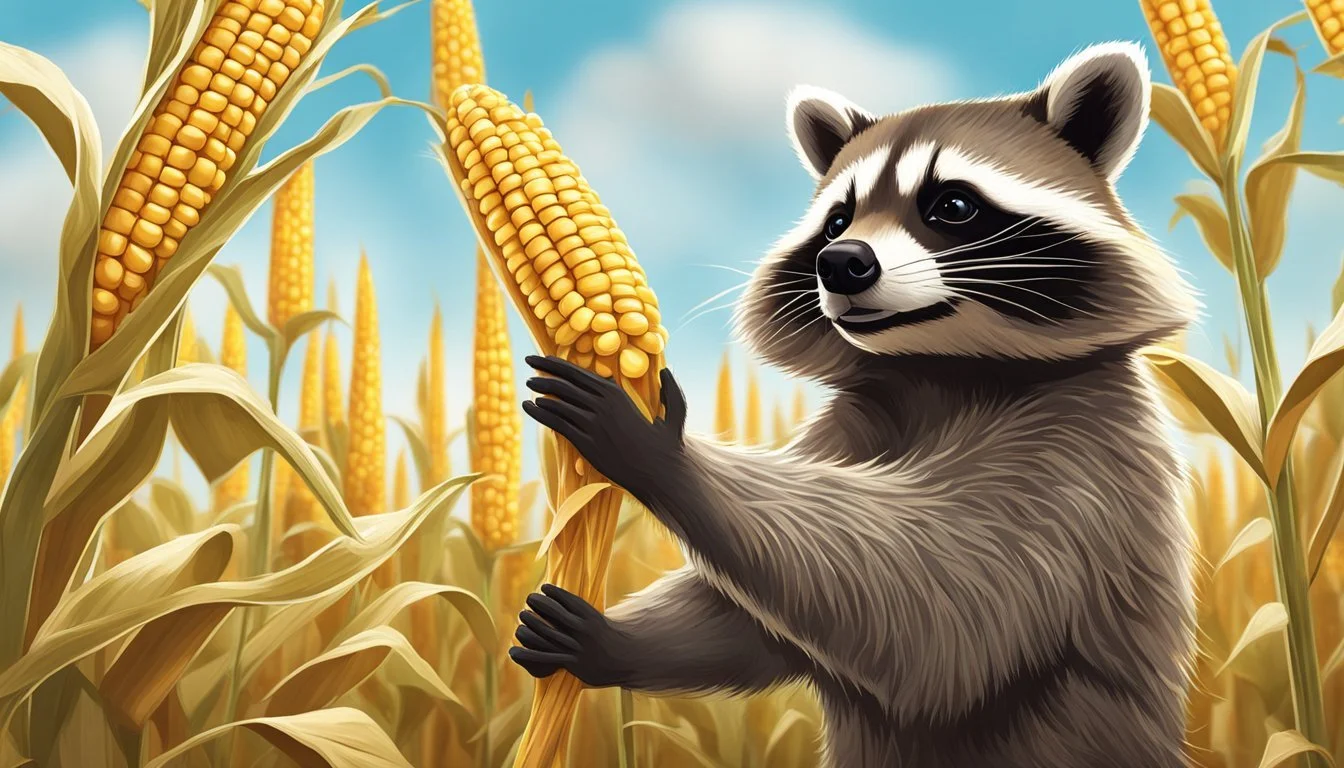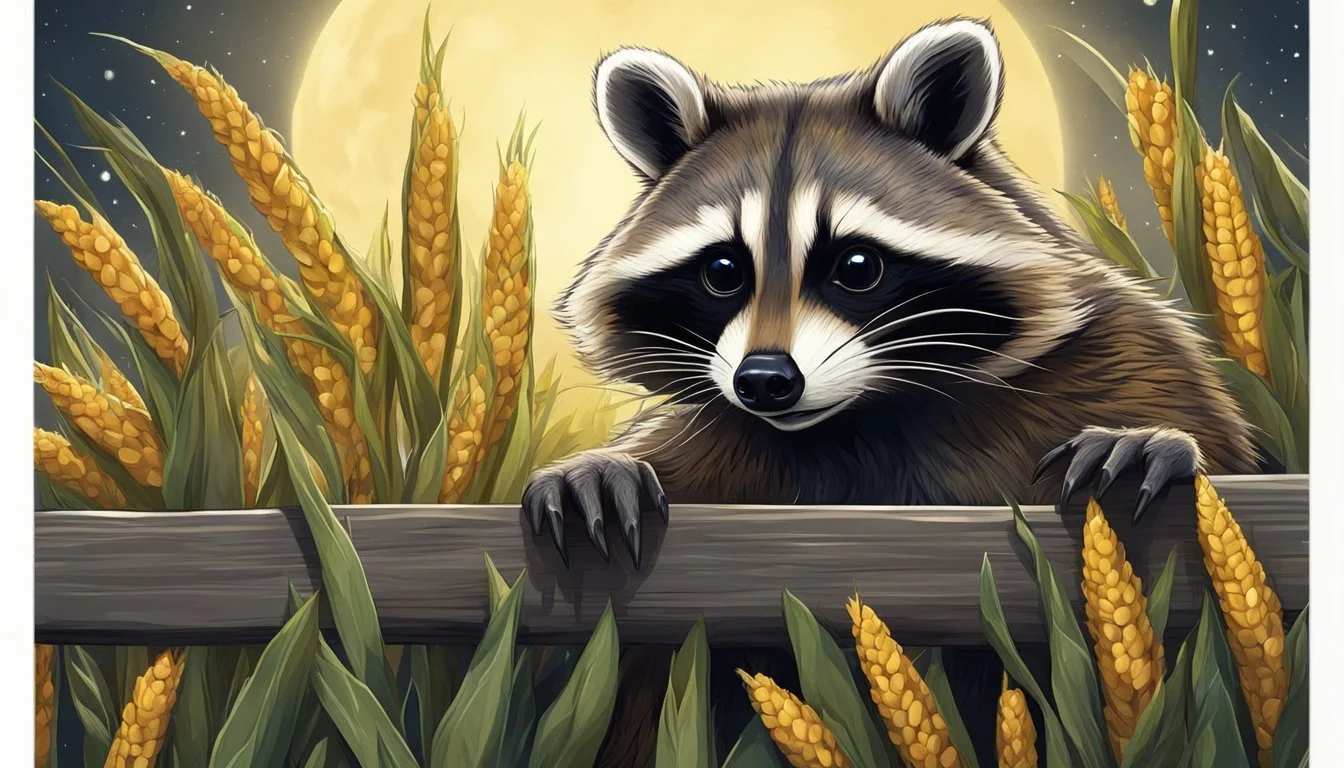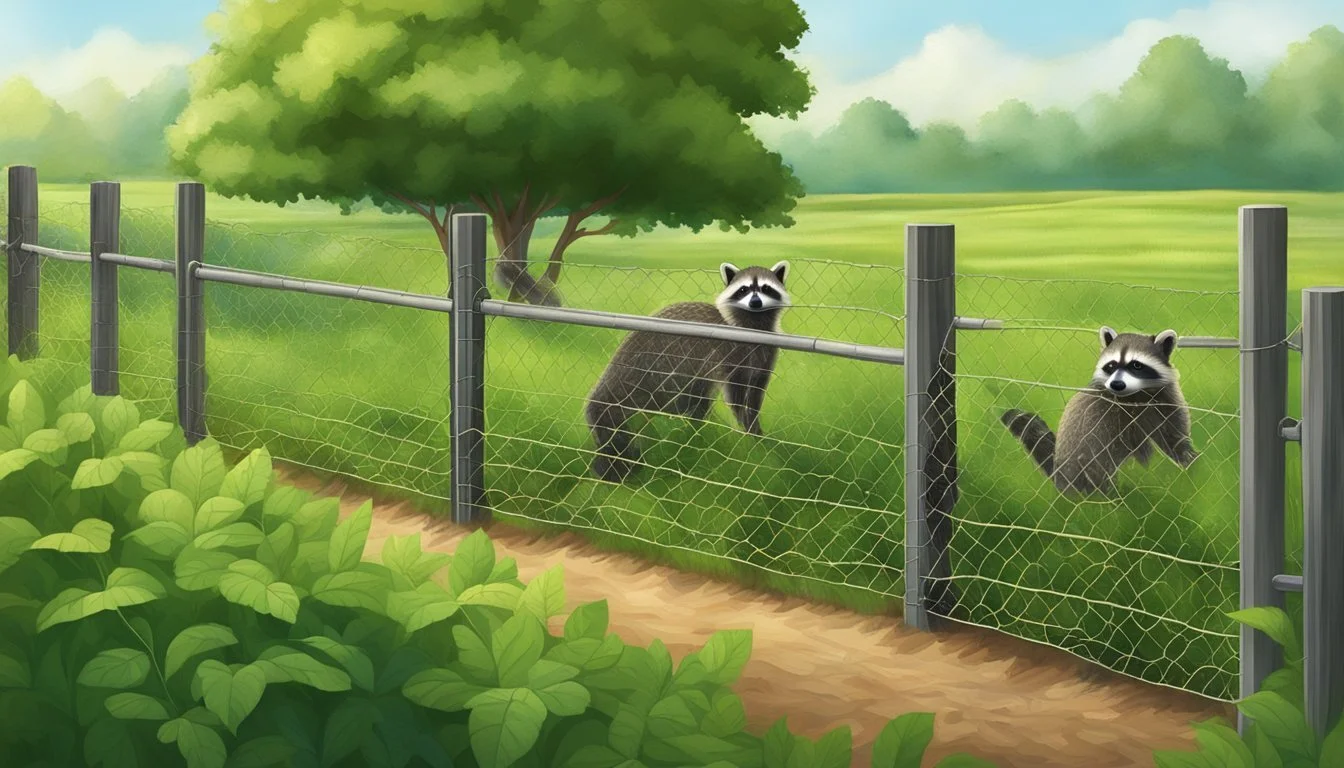Protecting Crops from Northern Raccoon
Effective Deterrence Strategies
The Northern Raccoon (Procyon lotor) is a highly adaptable mammal that has made its way into various habitats across the United States, Canada, Mexico, and parts of Central America. As opportunistic feeders, raccoons have developed a knack for raiding crops, which poses a considerable challenge for farmers and gardeners. Their dexterous front paws and intelligent problem-solving abilities allow them to access a variety of food sources, often leading to significant agricultural damage.
Farmers have long been in a battle to protect their livelihoods from these nocturnal creatures. The key to mitigating raccoon-induced damage lies in understanding their behavior and implementing effective deterrent strategies. Without adequate protection, raccoons can cause extensive harm to cornfields, orchards, and vegetable gardens, impacting both yield and profit.
Effective raccoon management requires a combination of methods, including physical barriers, habitat modification, and control measures. In-depth knowledge of raccoon habits and ecology can empower landowners to devise strategies that minimize crop loss while coexisting with these ubiquitous mammals. It is vital to employ humane and environmentally sustainable practices to ensure that solutions for crop protection do not adversely affect local wildlife populations or ecosystems.
Raccoon Identification
Identifying raccoons is essential to understand how they interact with crop environments and the potential damage they can inflict.
Species Overview
Raccoons belong to the family Procyonidae. They are known for their adaptability to various habitats and often live in close proximity to human establishments. The Northern raccoon (Procyon lotor) is the species commonly found across North and Central America, from Canada to Panama.
Physical Characteristics
Northern raccoons are distinguishable by their bear-like body shape and characteristic facial markings. They possess a dense underfur and outer coat that ranges from gray to black, suitable for various climates. Physical features include:
Size: They can measure in length from 16 to 28 inches, excluding their bushy tails, which add an additional 10 inches.
Weight: An adult raccoon typically weighs between 14 and 30 pounds, with males usually being larger than females.
Markings: The most iconic feature is their black facial mask, which contrasts with the white fur around it, enhancing their night vision capabilities.
Tails: With 4 to 7 black rings, their tails are also distinctive.
Dexterity: They have highly dexterous front paws, and studies suggest these attributes contribute to their adaptability.
With enhanced night vision and being agile climbers, raccoons can access food sources with ease, making crop protection a challenge where these animals are prevalent.
Raccoon Biology
Understanding the biology of the northern raccoon (Procyon lotor) is critical for managing their impact on crops. This section explores their diet and feeding habits, reproductive cycle, and behavior patterns, which are essential for developing effective control measures.
Diet and Feeding Habits
Northern raccoons are omnivorous creatures, displaying a flexible diet depending on the season and available food sources. They consume a variety of foods including acorns, nuts, berries, and bird eggs. Animal-based foods in their diet include frogs, fish, insects, crayfish, rodents, and moles. In areas near human settlements, raccoons are known to raid garbage and litter for food, often leading to conflicts with humans.
Reproduction and Lifespan
Raccoons typically have a breeding season that ranges from late winter to early spring. After a gestation period of about 63 to 65 days, a female raccoon gives birth to a litter consisting of two to five young, commonly referred to as kits. The lifespan of raccoons in the wild averages 2 to 3 years, though they can live up to 5 years in favorable conditions.
Behavior and Activity Patterns
Raccoons are primarily nocturnal, being most active at night. They exhibit seasonal changes in activity, typically reducing their movement during the winter months. Although they do not hibernate, raccoons may "hole up" in dens during serious winter weather. Their social organization is complex, with adult males maintaining territories that rarely overlap, while females may reside in overlapping home ranges.
Raccoon Habitat
Raccoons demonstrate specific preferences in habitat selection, typically opting for environments that provide ample food sources, water, and denning opportunities. Understanding these preferences and home range behaviors is crucial for effective crop protection.
Habitat Preferences
Raccoons favor wooded areas because they provide a rich supply of food and shelter. They are commonly found in hardwood forests, as well as bottomland forests which are often adjacent to streams and flooded areas. In these habitats, raccoons have access to a diet rich in invertebrates, plant material, and vertebrates. The proximity to water is also essential, not only for hydration but also because raccoons are adept swimmers and will exploit aquatic food sources found in marshes, reservoirs, and, in coastal regions, mangrove swamps.
Hardwood Swamps: A commonly chosen habitat due to the abundance of potential den sites.
Urban Areas: Increasingly common as raccoons adapt to human development, utilizing storm drains and attics as dens.
Home Range and Dens
Raccoons are territorial animals with a defined home range that varies in size depending on the availability of food and dens. This range can be between 1-3 square miles for urban raccoons and even larger for those in more rural areas. Preferred denning sites include hollow trees, fallen logs, and abandoned burrows. In urban settings, raccoons may use attics, abandoned buildings, or crawl spaces. Distribution extends from Southern Canada to British Columbia and includes a variety of wildlife management areas. They are resourceful in selecting denning sites, often choosing locations close to their food sources and away from potential threats.
Hollow Tree: A prevalent den site.
Urban Areas: Raccoons utilize storm drains and attics when natural den sites are scarce.
Distribution: Spanning from Southern Canada through the United States to British Columbia.
Threats and Challenges
Northern raccoons pose significant risks to crop protection due to their behavior and interactions with other species. Understanding these threats and challenges is essential for developing effective management strategies.
Diseases and Parasites
Northern raccoons are carriers of several zoonotic diseases, which can transfer to other wildlife, domestic animals, and humans. Rabies is one of the most notable diseases associated with raccoons. This viral disease affects the central nervous system and can be fatal if not promptly treated. Raccoons can also carry canine distemper, a contagious and serious disease that affects dogs and other carnivores.
Predators and Competitors
Raccoons face predation and competition from various animals. Larger predators such as bobcats and coyotes pose a natural threat to raccoon populations. They compete with raccoons for food and territory, which can influence raccoon behavior and impact crop protection efforts. Additionally, domestic animals like dogs can also become involved in conflicts with raccoons, leading to further disease spread and challenges in managing raccoon populations.
Crop Protection Strategies
Effective crop protection against Northern raccoons requires tailored strategies that mitigate wildlife damage and accommodate the behaviors of this adaptable species. Particular attention is needed when they become nuisances in areas such as Florida, where their interaction with anthropogenic resources can lead to significant crop damage, especially in corn.
Physical Deterrents
Fencing is a primary line of defense to protect crops. Sturdy fences, preferably electric or with a tight mesh, can deter raccoons from entering crop fields. Wire mesh covers can prevent raccoons from accessing smaller areas, especially during peak nesting periods when the tendency to forage in agricultural lands increases.
Net barriers are another form of physical deterrent, especially useful for preventing raccoons from climbing into trees or shrubs to reach fruits.
Biological Control Methods
Introducing biological control agents that target raccoon food sources can reduce their interest in crops. This strategy requires careful planning to balance the ecosystem and avoid unintended consequences for native species.
For instance, employing predatory insects to manage pest populations that raccoons feed on forces these opportunistic feeders to look elsewhere for sustenance.
Nuisance Wildlife Management
A strategic approach to managing nuisance wildlife often includes habitat modification; limiting access to shelter and food can discourage raccoons from settling in the area. This involves securing garbage bins and removing pet food from outdoor areas, effectively reducing anthropogenic resources that attract raccoons.
Crop damage assessment is also part of wildlife damage management, where farmers monitor losses to implement necessary changes promptly. Certain humane traps and relocation efforts may be warranted where raccoon populations are high, aligning with invasive species management when these animals are not native to the ecosystem.
In implementing these strategies, it is critical to comply with local wildlife protection regulations, ensuring the balance between crop safety and respecting the role raccoons play in their native habitats.
Human-Raccoon Interactions
Northern raccoons have adapted to urban landscapes, leading to nuanced interactions with humans. This section examines the impact on urban areas, the public health concerns they may pose, and the necessary steps for effective conservation and management.
Urbanized Populations
In urban areas, Northern raccoons have become a common sight due to range expansion and adaptability. These urbanized populations often become a nuisance due to their scavenging habits, leading to conflicts with humans. They are known to rummage through trash cans, causing messes and potentially spreading waste. Urban raccoon populations benefit from living in close proximity to humans due to the presence of consistent food sources. However, their habits necessitate intervention methods to reduce human-raccoon conflicts and preserve urban ecosystem services.
Public Health Concerns
Raccoons can carry zoonotic diseases such as rabies, posing public health concerns to the communities they inhabit. They can also host parasites that may affect human health. Public education on avoiding feeding raccoons and securing garbage can mitigate these risks. Special attention should be given to ensuring rabies vaccination programs are maintained to mitigate the potential for disease transmission.
Conservation and Management
Effective conservation and management strategies are essential to balance the presence of raccoons with human interests and safety. Wildlife management programs focus on non-lethal methods, like habitat modification and exclusion techniques, to prevent raccoon access to potential denning sites, like attics or crawl spaces. In some areas, laws are in place to manage raccoon populations humanely, reflecting a commitment to preserving wildlife while protecting human interests.
Raccoon Ecology
When examining the ecological role of the Northern raccoon, particularly concerning agriculture, it's critical to understand their feeding habits, population dynamics, and impact on the environment.
Feeding Ecology
The Northern racoon (Procyon lotor) demonstrates omnivorous and opportunistic feeding behavior, often affecting local fauna and flora. Their diet includes birds, rabbits, mink, and the Northern Bobwhite, which may impact bird populations if raccoons can easily access them. They also consume a wide range of fishes, impacting freshwater ecosystems. Their feeding habits can stretch to bat populations due to predation of roosting individuals. In agricultural settings, raccoons can cause considerable damage to crops and potentially spread diseases to livestock.
Population Dynamics
Raccoons are known for their adaptability and high reproductive potential. A female raccoon, referred to as a sow, can give birth to a litter of typically four to six pups annually. However, it's important to note that high mortality rates among juveniles often balance these birth rates. Population densities can be influenced by factors such as availability of food sources and habitat, predation, and disease. Urban environments often witness higher population densities due to the abundance of food and lack of predators.
Environmental Impact
Northern raccoons play a complex role in their ecosystems. They can control populations of smaller predators, such as mink, and certain pests. However, their propensity to predate on native species can disrupt local ecological balances. In terms of ecosystem services, raccoons have a dual nature. While they can help control agricultural pests, they might also damage crops and impact the populations of beneficial species, thereby affecting the ecosystem services these creatures provide. Due to their ability to adapt, raccoons often thrive in human-altered landscapes, which can further complicate their impact on the environment.
References
Kuchler Plant Associations
Raccoons are opportunistic feeders, and their presence can be influenced by the types of vegetation found within different Kuchler Plant Associations. As the habitat types vary, the strategies for crop protection may also need to adapt to the local flora that could provide cover or additional food sources for raccoons.
SAF Cover Types
When considering crop protection, understanding the SAF Cover Types can help farmers anticipate raccoon behavior. For instance, raccoon populations have thrived in agricultural landscapes where corn and other crops offer increased foraging opportunities.
SRM (Rangeland) Cover Types
On rangelands, raccoons may disrupt the ecosystem balance. Rangeland managers should be aware of SRM Cover Types when devising management plans to deter raccoons and protect their crops from these animals.
Plant/Habitat Associations Relevance to Crop Protection Kuchler Dictates local raccoon food sources. SAF Aligns crop protection with forest types. SRM Helps in anticipating raccoon activity on rangelands.
Adaptations: Farmers need to consider local wildlife adaptations to minimize damage.
Monitoring: Regular monitoring of raccoon activity is crucial to safeguard crops.
Habitat Alteration: Farming practices might necessitate changes to reduce raccoon attractiveness.
In the context of Northern Raccoon management, one should note that in regions like northern Europe, raccoons are expanding their range due in part to climatic shifts. In Japan, raccoons are recognized for agricultural damage and affecting local biodiversity. An understanding of these references can support the development of effective raccoon deterrent strategies.
Frequently Asked Questions
Addressing the concerns regarding raccoon-related crop damage involves implementing a variety of deterrents, repellents, and agricultural practices. Here are some specific strategies to protect crops effectively.
How can one deter raccoons from devouring agricultural crops?
Farmers can deter raccoons by using physical barriers such as electric fencing or metal mesh. Ensuring that trash bins are sealed and not leaving pet food outside can also reduce the likelihood of raccoons visiting crop areas.
Which natural repellents are effective against raccoon intrusion in farms?
Natural repellents that can be helpful include cayenne pepper or homemade sprays containing garlic or onion. Regular application around the perimeter of crops may help keep raccoons at bay.
Which agricultural practices minimize damage caused by raccoons in gardens and fields?
Implementing crop rotation and timely harvesting ensures that raccoons have less incentive to feast on crops. Using netting or row covers for smaller garden areas can also prevent access.
What are safe methods for protecting cornfields from raccoon damage?
Securing cornfields can be done by installing electric fences that are specifically designed to keep out raccoons, using a few strands of wire placed at different heights.
How can I safeguard my vegetable plants, such as tomatoes, from raccoons?
To protect vegetables like tomatoes, use elevated garden boxes and cover them with protective netting. Keeping the garden clean and free of fallen fruits can also discourage raccoon visits.
In what ways can smells be used to prevent raccoon presence in agricultural areas?
Raccoons have a strong sense of smell, so distributing unpleasant scents such as ammonia-soaked rags or mothballs around the farm can act as a deterrent. However, these should be used with caution to avoid contaminating the soil or crops.









